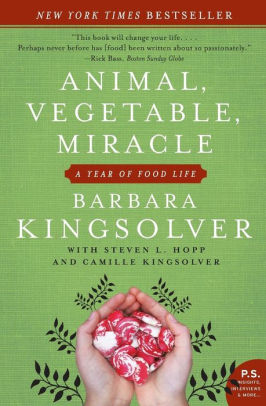I have long loved Barbara Kingsolver’s fiction works, and found this to be a lovely exploration of what challenges and victories await when we think long and hard about what we eat and from where it comes. It made me re-think the meals I order in restaurants, and how I shop for groceries.
Kingsolver and family provide a fun and interesting way to really deepen our understanding of how long and complex our food supply chains have become. In determining to only eat local food, with the majority coming from their own garden, for a year, the family embarks on an adventure in restraint and patience that results in the joy that comes with hard earned rewards.
By involving all family members, this work offers multiple points of view on the exercise of eating local. This literary construct enables more readers to connect with the message of the book: those who don’t find Barbara or Steven’s point of view resonating with them, for example, may find joy and alignment with how Camille views the experience.
Growing up with easy access to a farm – often with our neighbor’s cattle grazing on it – I had the luxury of understanding the relationship between living cow and burger. Many years later, living in downtown Washington, DC, and central London, I was shocked at how many young people are missing that fundamental connection with their food.
I haven’t known that many young people that are lacking a cursory understanding of the connection between “beef” and “cow”, though I have heard the stories, and watched the documentaries that demonstrate that is a growing phenomenon in our inner cities. That being said, I have known quite a few young and old people that, while they understand the connection, aren’t comfortable with it.
In the market in Marrakesh, Morocco, on a recent family holiday, we saw live chickens go from caged transport, to a pen in the market, to execution, de-feathering, and sale. I’ll admit, my kids made some pretty funny faces as blood splattered across the wall next to the de-feathering machine.
While they know that chicken meat comes from what was a live chicken, they very rarely see the lifecycle live in front of them. It is a different experience to raise and care for an animal (or visit it regularly at the farm next door), and then to eat it. It gives you greater respect for the hard work that went into rearing the animal and healthy gratitude for what was sacrificed to fill your belly.
Animal, Vegetable, Miracle brings that cycle to live through the experiences of the Kingsolver family. It prompts us all to be more thoughtful when we pick food off the shelves – or, perhaps, where possible, to forget the shelf altogether and source food from local farms. When we shop in grocery stores (as I do every week!), we make loads of choices. Animal, Vegetable, Miracle reveals the joy we can find when we remind ourselves of the natural seasonal cycles of our food.
We are quite lucky here in the UK that our fresh fruit and vegetables have long since had labels telling consumers where they were grown. That simple thing, in and of itself, makes it so easy to choose items grown closer to home, and closer to their natural season. I rarely buy strawberries and asparagus outside of their natural, British, seasons anymore. Don’t get me wrong – I’m no saint; I do make a strawberry pudding in December every now and again!
But, I find that reducing those indulgences to rare “treats”, and primarily sticking to enjoying fruit and veg in seasons makes it that much more special to enjoy them. It also has the added benefit of allowing me to enjoy seasonal fruit and veg when it is at its best. British strawberries in summer truly do taste better than the half-ripe ones imported in December and January.
For the purposes of transparency, though, let’s be clear – I do have my weaknesses – just like the Kingsolver family – my love of coffee and avocados probably undoes all my good strawberry and asparagus work. And, in the grand scheme of things, the carbon footprint of transport is a very small part of the carbon footprint associated with food production. From a purely emissions point of view, you are better off eating imported asparagus over local beef.
Despite the emissions data, there are great benefits to understanding our food supply chain and getting closer to it. Animal, Vegetable, Miracle lays those out beautifully in an easy to read, joyful celebration of our relationship to the land.

 Doughnut Economics
Doughnut Economics Sustainable Beauty: Practical Advice and Projects for an Eco-conscious Beauty Routine
Sustainable Beauty: Practical Advice and Projects for an Eco-conscious Beauty Routine